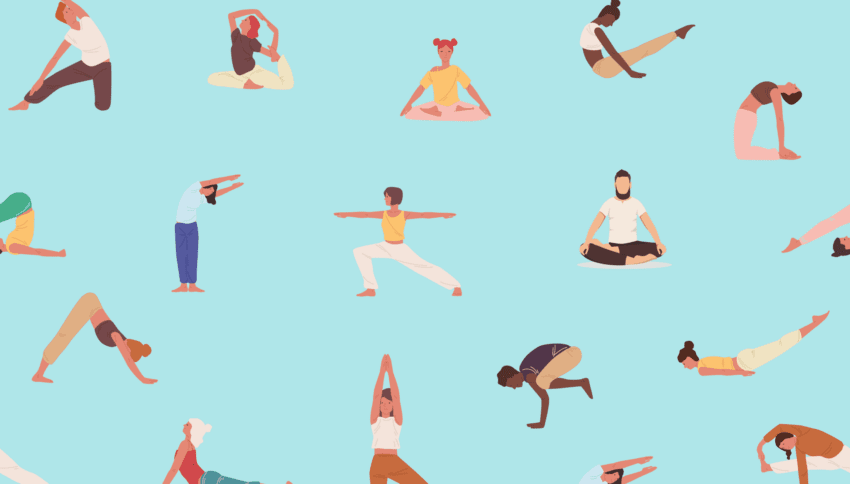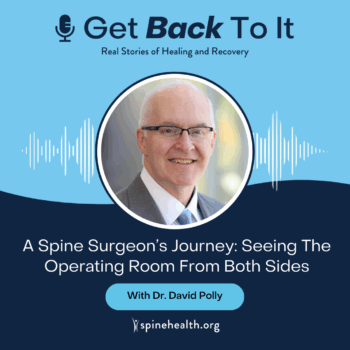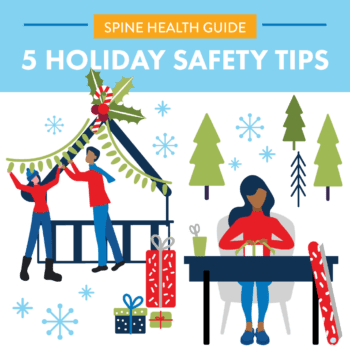A staggering 60%–80% of adults are likely to experience back pain at some point in their lives. But 85% of back pain cases have an unknown cause. In cases like these especially, stretching can be an effective way to alleviate pain. In one study, patients who completed a four-week stretching and flexibility program saw an average improvement of 58% in their back pain.
Creating a habit of stretching at least once a day can ease discomfort in your back and neck, prevent further back and neck pain, and improve your spine health. By incorporating stretching into your daily routine, you improve the overall health and resilience of your back muscles.
Note, however, that stretching should be done gently and gradually, without forcing the body into painful positions. Listen to your body! You should also consult with a healthcare professional before starting any new stretching routine, especially if you have a history of back and neck problems or other medical conditions.
In this article, we will discuss:
- How does stretching help with back and neck pain?
- Does stretching help your posture?
- Can stretching prevent spinal degeneration?
- Five great stretches for back and neck pain
- Yoga for back and neck pain
- Myofascial release therapy to complement stretching
How does stretching help with back and neck pain?
Stretching helps to relax tense muscles in the back and neck. Tight muscles in the back, hips, and legs can exert pressure on the spine. Stretching these muscles helps to reduce compressive forces on the spine, alleviating pain and discomfort associated with conditions like herniated discs, spinal stenosis and degenerative disc disease.
Stretching also increases blood flow to the muscles, which means more nutrients and oxygen are delivered to the tissues. Improved circulation also removes metabolic waste products that can contribute to muscle soreness and stiffness.
Finally, many stretching exercises engage the core muscles, which play a critical role in supporting the spine. Strengthening and stretching the core muscles through stretching exercises can improve spinal stability and reduce the risk of back and neck injuries.
Does stretching help your posture?
Poor posture is often a result of tight muscles that pull the body out of alignment. For example, sitting for a long period of time can lead to tightness in the hip flexors, which can tilt the pelvis forward and create an exaggerated curve in the back. Stretching these tight muscles helps to lengthen them, reducing the pull on the body and allowing for better alignment.
Sometimes, weak muscles are the culprit in poor posture. Stretching the chest muscles, for example, can help counteract the forward rounding of the shoulders that often occurs with slouching posture. It also reduces forward head posture, where the head juts forward from the shoulders.

Many people experience back and neck pain due to poor posture, which can result from tight muscles and imbalances in the musculoskeletal system. Stretching exercises that target muscles involved in maintaining proper posture, like the core, back, and hips, can help correct imbalances and promote better alignment of the spine.
Stretching regularly also makes you more aware of your body in general. You learn to recognize poor posture and adjust it more quickly, and you can also become more aware of which muscles are tighter than others. Stretching regularly leads to long-term overall improvements in posture.
Can stretching prevent spinal degeneration?
As we age, the spine undergoes degenerative changes that can lead to conditions like osteoarthritis, degenerative disc disease, and spinal stenosis. Regular stretching helps maintain spinal health by preserving flexibility, promoting proper alignment, and reducing the risk of degenerative changes.
Muscle imbalances (when certain muscles are stronger or tighter than others) can contribute to spinal degeneration because they place uneven stress on the spine. Stretching targets both tight and weak muscles, helping to restore balance to your body and its structures. It also minimizes the wear and tear by countering the compressive forces on the spine and can help reduce the risk of conditions like disc herniation and spinal stenosis.
Five great stretches for back and neck pain
At the National Spine Health Foundation, our work is informed by expert doctors, physical therapists, and other spine health professionals about ways to prevent and alleviate back and neck pain. Here are five easy stretches that are shown to help alleviate and prevent back and neck pain. Incorporating these into your daily routine may be helpful to eliminating and preventing pain, while allowing for greater range of motion and mobility so you can live your life on your terms.
1. Child’s Pose Stretch
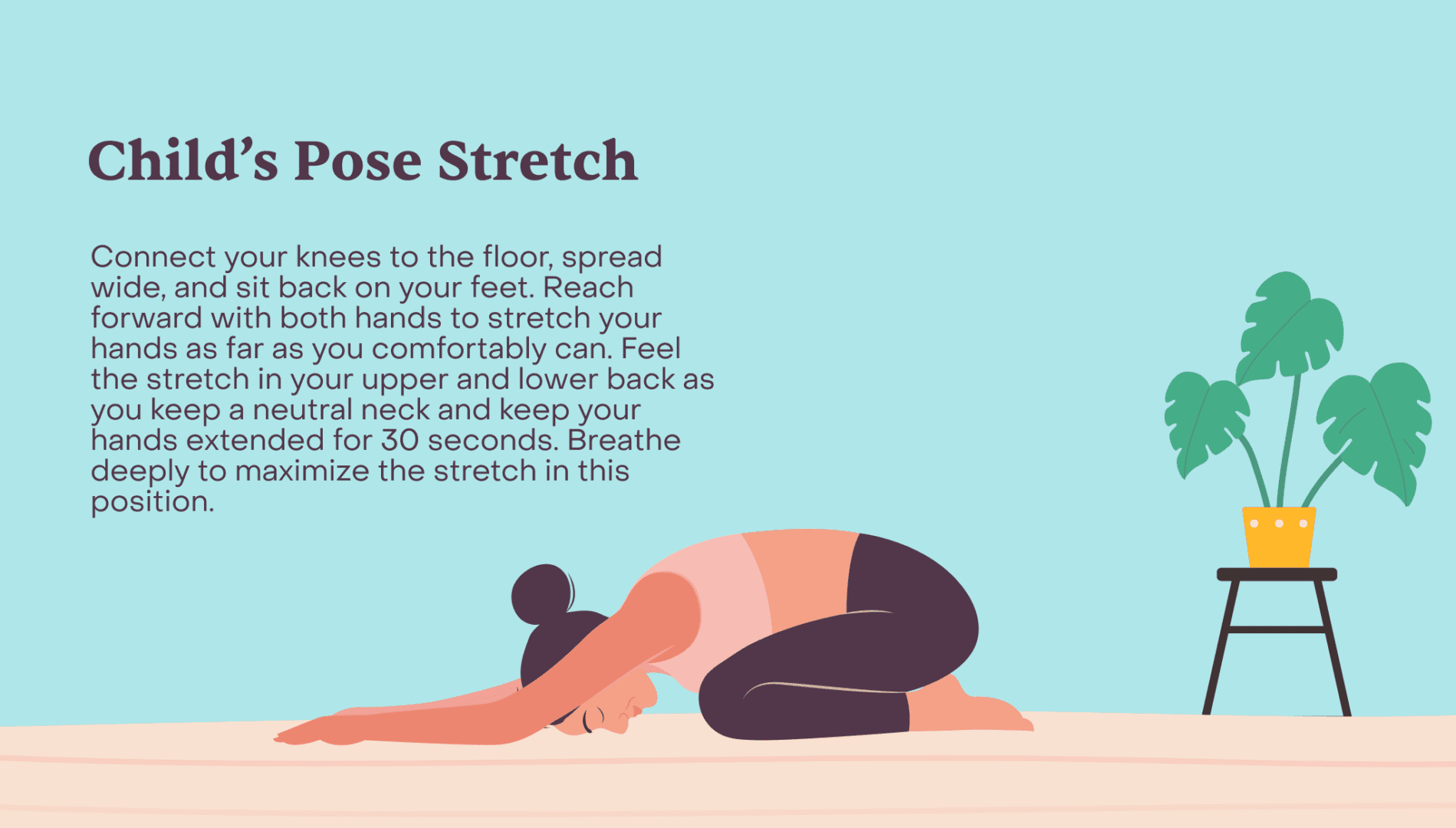
Instructions: Connect your knees to the floor, spread knees wide and feet together, and sit back by lowering your hips towards your feet. If this is too much pressure on your knees, you can try placing a pillow behind your knees. Reach forward with both hands to stretch your hands as far as you comfortably can while resting your forehead to the ground.. Feel the stretch in your upper and lower back as you keep a neutral neck and keep your hands extended for 30 seconds. Breathe deeply to maximize the stretch in this position.
2. Hip Crossover Stretch

Instructions: Sit on a chair. Cross your one ankle over the opposite knee, keeping the leg parallel to the floor, keeping the ankle squared near the bend of the knee. Keeping core tight, lean slightly over at the hips and feel the stretch in the right hip and glute of the crossed leg. Hold for 30 seconds, then switch legs. Exhale as you lean forward to maximize the stretch.
3. Hamstring Stretch
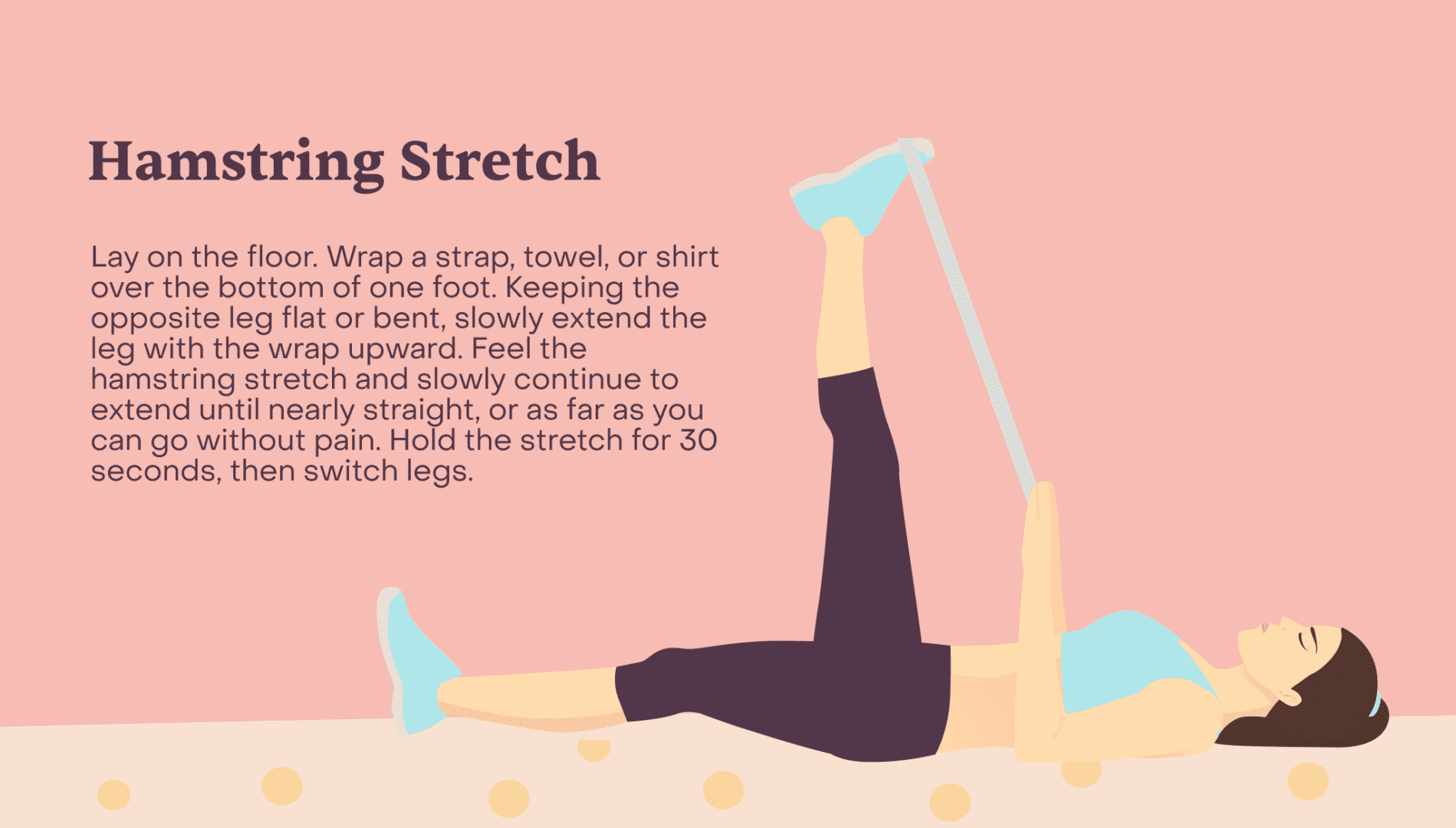
Instructions: Lay on the floor. Wrap a strap, towel, or shirt over the bottom of one foot. Keeping the opposite leg flat or bent, slowly extend the leg with the wrap upward. Feel the hamstring stretch and slowly continue to extend until nearly straight, or as far as you can go without pain. Hold the stretch for 30 seconds, then switch legs.
4. Side Stretch
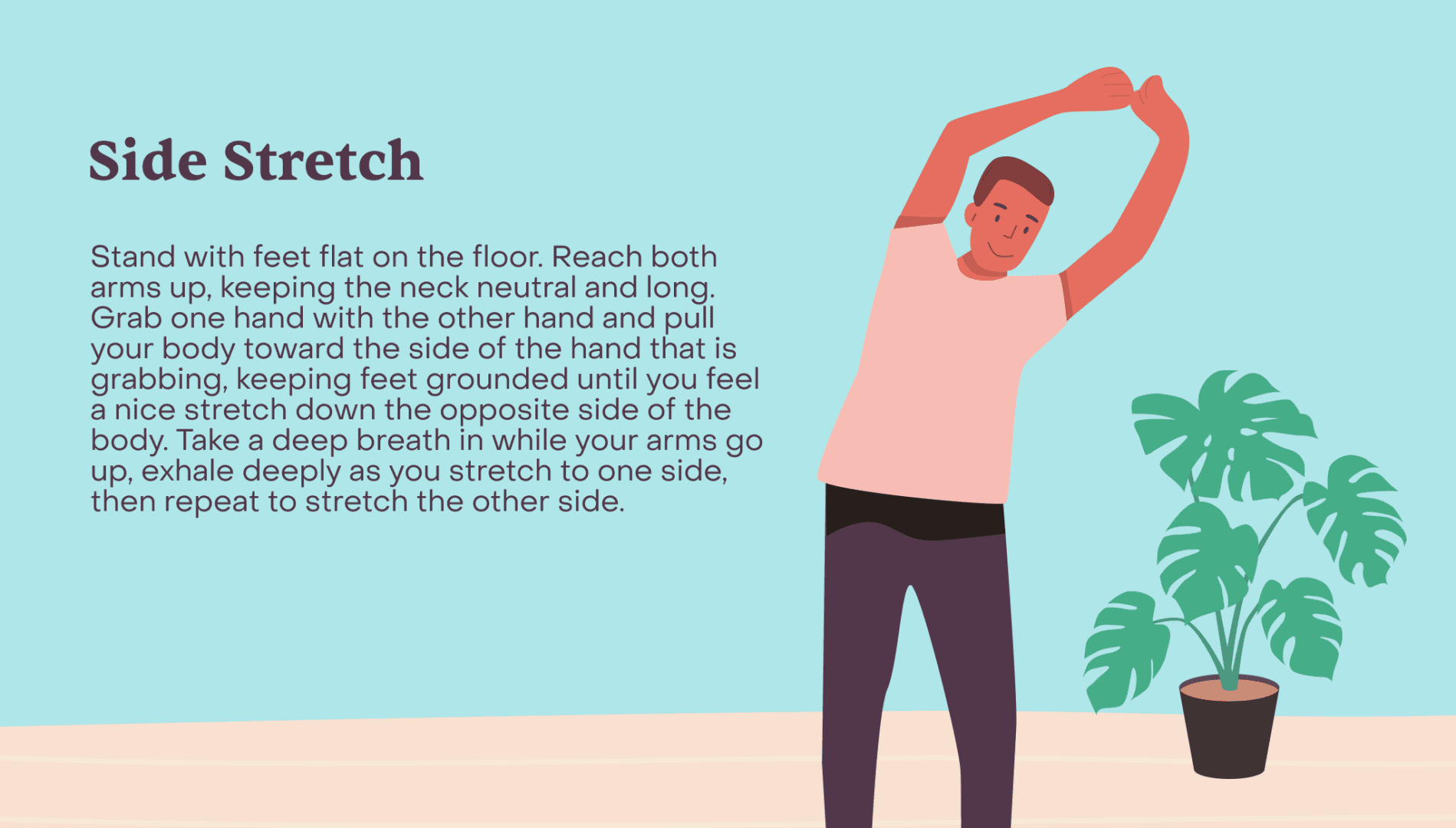
Instructions: Stand with feet flat on the floor. Reach both arms up, keeping the neck neutral and long. Grab one hand with the other hand and pull your body toward the side of the hand that is grabbing, keeping feet grounded until you feel a nice stretch down the opposite side of the body. Take a deep breath in while your arms go up, exhale deeply as you stretch to one side, then repeat to stretch the other side.
5. Behind-the-Back Neck Stretch
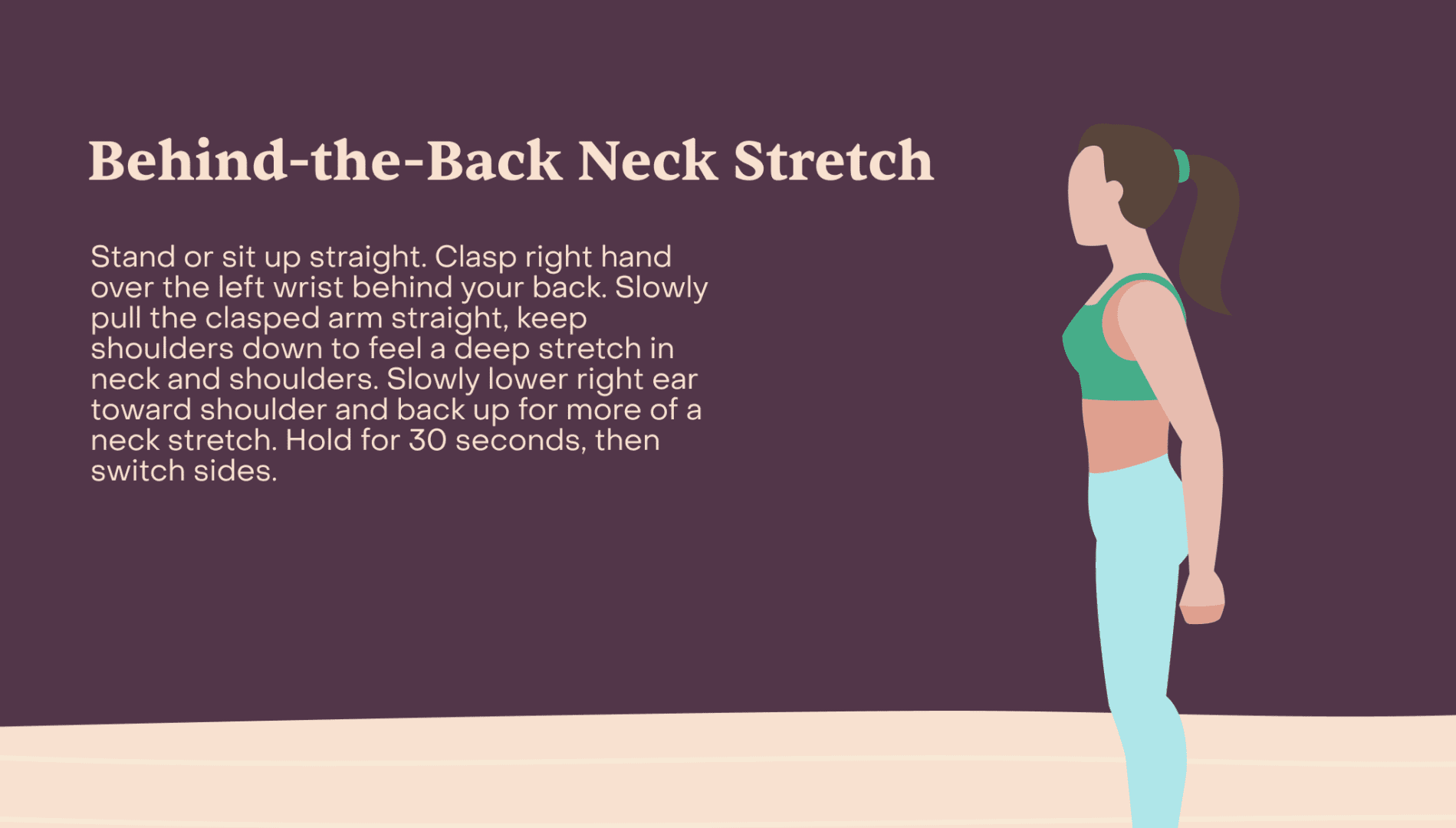
Instructions: Stand or sit up straight. Clasp right hand over the left wrist behind your back. Slowly pull the clasped arm straight, keep shoulders down to feel a deep stretch in neck and shoulders. Slowly lower right ear toward shoulder and back up for more of a neck stretch. Hold for 30 seconds, then switch sides.
Yoga for Back and Neck Pain
The poses of yoga, or asanas, are muscular stretches. Therefore, yoga can be very effective in treating back and neck pain, and can prevent future pain. Yoga improves flexibility, balance, range of motion in the joints, and muscle tone. Holding a yoga pose can improve poor body alignment that can be contributing to pain.
The discs that cushion the vertebrae act as gelatinous shock absorbers that have limited blood supply. They depend on movement of the surrounding structures to aid in the delivery of nutrients. Movement supports the maintenance of disc fluid, which is important for people who experience back and neck pain.
A kind of yoga called “iyengar yoga” is one of the best types of yoga for back and neck pain. This type of yoga combines asanas (yoga postures), pranayama (breath control), and the use of props to achieve anatomical alignment.
In one randomized 16-week trial, participants assigned to practice iyengar yoga had significant reductions in pain intensity, functional disability (including spinal range of motion), and use of pain medication. Before the study, participants had an average of 11.2 years of low back pain.
One important benefit of yoga is the awareness it brings to your body. Mindful movement, focusing on fluidity and breath awareness to release tension and enhance mobility, can soothe tight, sore muscles while leaving you calm and refreshed. It’s helpful to end sessions with a meditation or relaxation pose.
Easy yoga poses for back and neck pain
This is not a comprehensive list of poses, but aim to start using these six poses in your practice several times a week and notice how your back and neck tension begins to change over time.
1. Seated Figure Four

Instructions: Use this common yoga pose to stretch both hips and relieve back pain. Notice the comforting feeling of stretch. Sit on your tailbone, lean back slightly onto your hands. Place your ankle over the knee of the opposite leg, keeping the shin parallel to the floor. Don’t go past a comfortable stretch. Hold stretch for 20-30 seconds. Repeat on the other side.
2. Bridge Pose
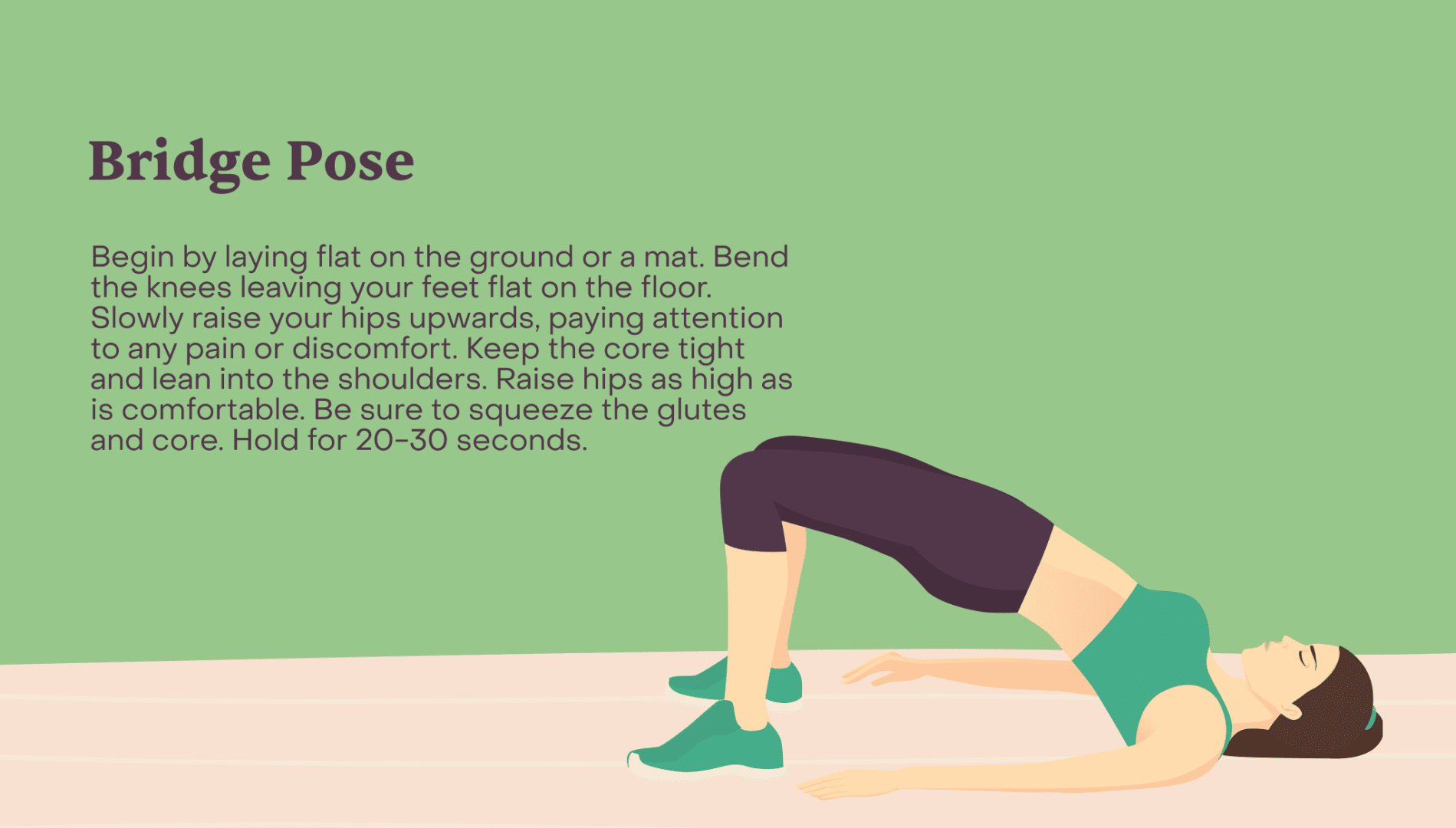
Instructions: Begin by laying flat on the ground or a mat. Bend the knees leaving your feet flat on the floor. Slowly raise your hips upwards, paying attention to any pain or discomfort. Point your knees towards the wall as you lift your hips. Keep the core tight and lean into the shoulders. Raise hips as high as is comfortable while exhaling. Be sure to squeeze the glutes and core. Hold for 20-30 seconds.
3. Cat-Cow Pose
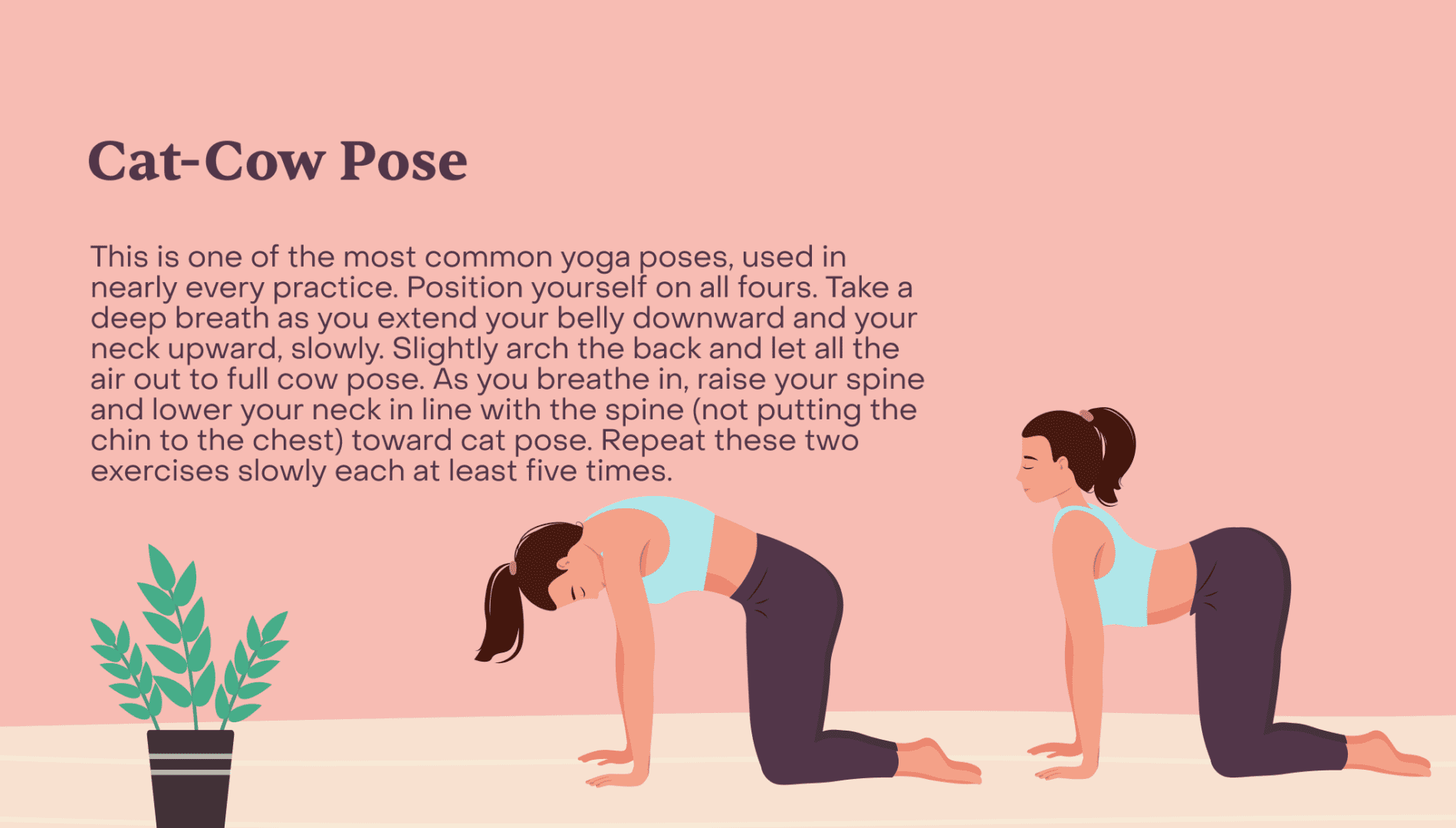
Instructions: This is one of the most common yoga poses, used in nearly every practice. Position yourself on all fours. Take a deep breath as you extend your belly downward and your neck upward, slowly by straightening the arms and pushing shoulder blades together. Slightly arch the back and let all the air out to full cow pose. As you breathe in, raise your spine and lower your neck in line with the spine (not putting the chin to the chest) toward cat pose. Repeat these two exercises slowly each at least five times.
4. Pigeon Pose

Instructions: Bend one knee in front of your body. Extend the other leg straight back and settle in on the bent leg. After getting into position, attempt to balance the weight of your body equally to both sides. Focus on the stretch in the hip of the bent leg. If you’d like, you can lift both hands, as in this photo. You can also put your hands on either side of the body or lean slightly forward. This is an advanced pose. Ways it can be modified include putting a pillow or block under the hip of your bent knee. Hold for 20-30 seconds. Repeat on the opposite leg.
5. Downward Dog
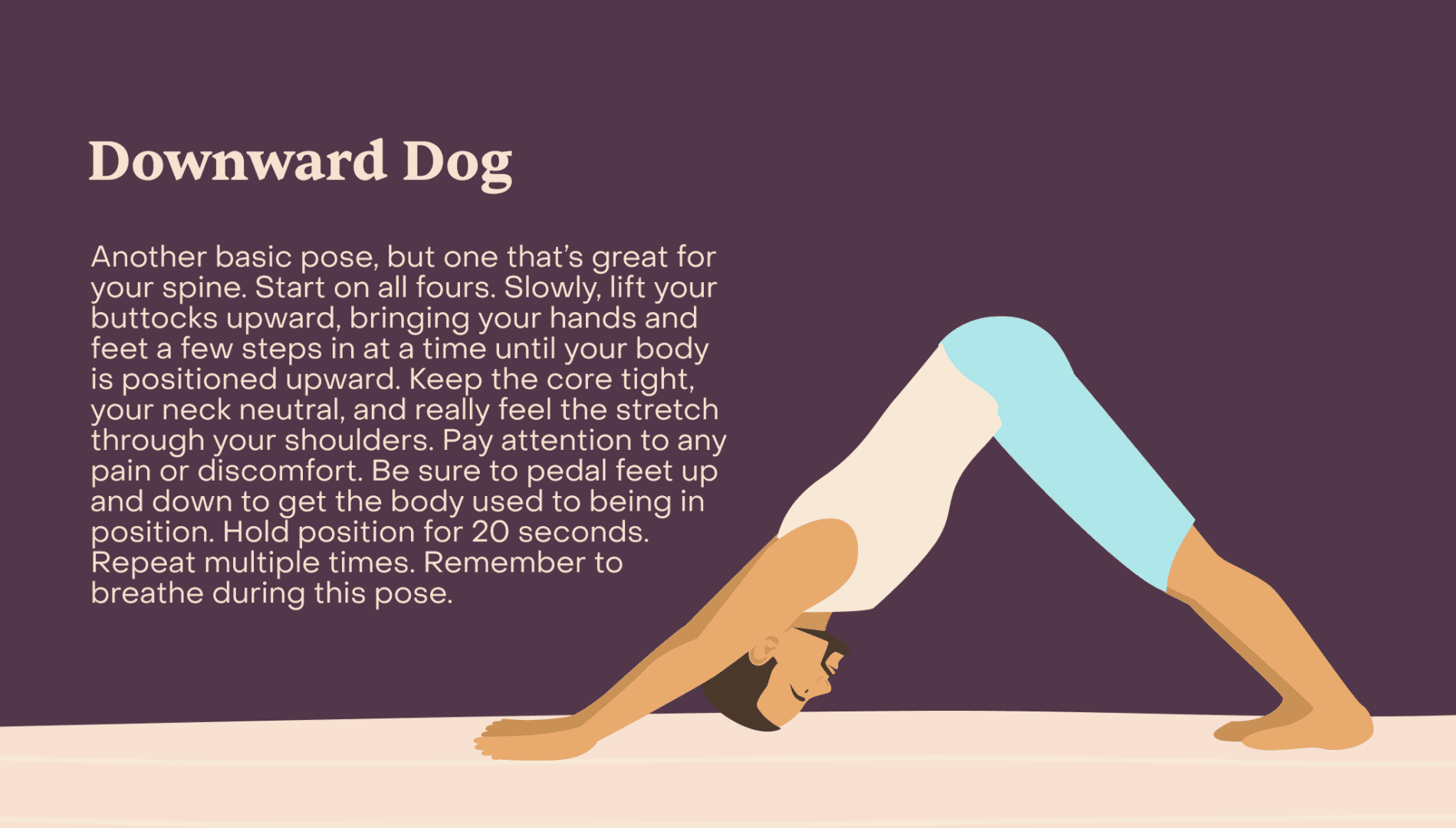
Instructions: Another basic pose, but one that’s great for your spine. Start on all fours. Slowly, lift your buttocks upward, bringing your hands and feet a few steps in at a time until your body is positioned upward. Keep the core tight, your neck neutral, and really feel the stretch through your shoulders. Pay attention to any pain or discomfort. Be sure to pedal feet up and down to get the body used to being in position. Hold position for 20 seconds. Repeat multiple times. Remember to breathe during this pose.
6. Sphinx Pose
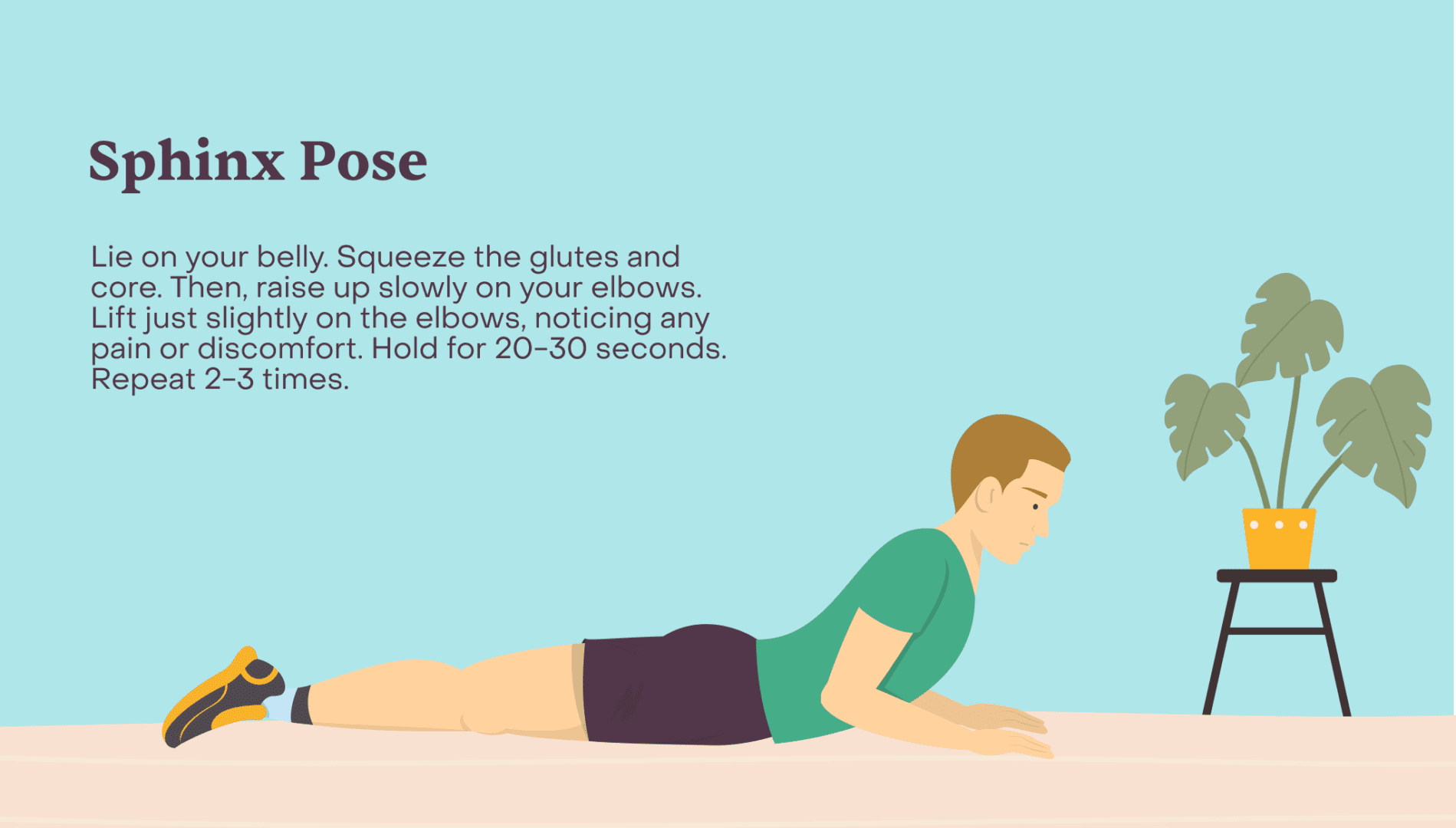
Instructions: Lie on your belly. Squeeze the glutes and core. Then, raise up slowly on your elbows, while exhaling. Lift just slightly on the elbows, noticing any pain or discomfort. Hold for 20-30 seconds. Repeat 2-3 times.
7. Extended Puppy Pose
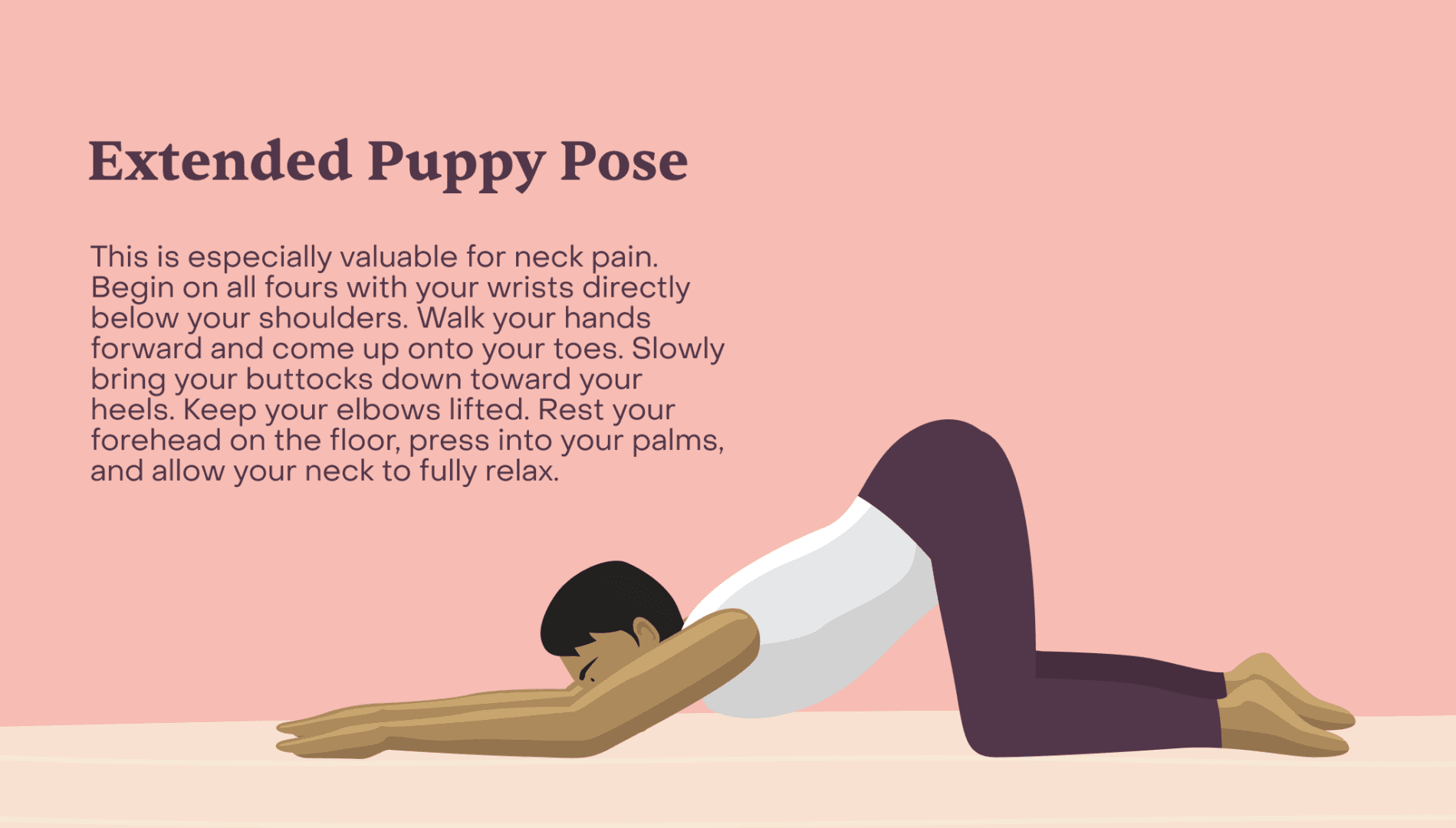
Instructions: This is especially valuable for neck pain. Begin on all fours with your wrists directly below your shoulders. Walk your hands forward and come up onto your toes. Slowly bring your buttocks down toward your heels. Keep your elbows lifted. Rest your forehead on the floor, press into your palms, and allow your neck to fully relax.
Myofascial release therapy to complement stretching
In addition to yoga and stretching, many people with back and neck pain find that myofascial release therapy eases their discomfort and improves their quality of life. Myofascial release therapy is a form of manual therapy that focuses on releasing tension in the tissues that surrounds and supports muscles. It does this by stimulating the body’s natural healing mechanisms and promotes proper alignment and function of the musculoskeletal system.
This therapy can alleviate pain and improve range of motion and can be beneficial for people with acute or chronic back pain. In one 2014 study, the addition of myofascial release therapy to specific back exercises did a better job at reducing chronic low back pain.
During myofascial release therapy, a trained therapist applies sustained pressure to targeted areas, allowing the muscles to relax and move more freely. The therapist may also apply gentle stretching techniques to encourage the muscles and tissue to relax.
For home use, you can purchase a myofascial release ball to help you stretch and hit different pressure points.
Myofascial release therapy can also help correct postural imbalances, promote relaxation by stimulating the parasympathetic nervous system. Talk to your doctor about whether myofascial release therapy could complement other activities you are doing to release back and neck pain, including stretching and exercise.
Conclusion
Incorporating stretching into your regular routine can play a significant role in your spine health. Stretching increases flexibility, improves posture, enhances circulation and reduces muscle tension – all of which are essential for a healthy spine. Yoga and myofascial release therapy can also complement the benefits of regular stretching, improving your overall well being.
Key Takeaways:
- Daily stretching can significantly alleviate back and neck pain by relaxing tense muscles, improving blood flow, and strengthening core support for the spine.
- Regular stretching and yoga can improve posture, and may reduce the risk of spinal degeneration by maintaining spinal flexibility and muscle balance.
- Incorporating complementary therapies like yoga and myofascial release therapy can further enhance the benefits of stretching by addressing pain, improving range of motion, and correcting postural imbalances.
